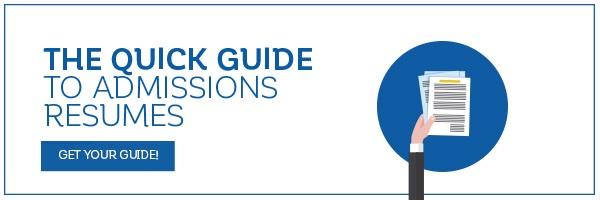

Although not officially required, you’re going to need a resume at some point in your medical school admissions process, either for completing the experience section of your application or to bring to interviews. While you can look up templates for a resume online, there are a few pointers you should keep in mind.
1. Keep it clean and easy to read.
The purpose of a resume is to have all of your information in one convenient place. Most admissions committee members will use the resume to remind themselves of where you went to school and where and when you worked. For that reason, keep it clear and neat. Don’t make the font too small or too fancy. Don’t put in pictures or other details. Design details will just distract the readers from your qualifications.
2. Emphasize academic excellence.
You should include all academic honors you’ve received as well as your major and GPA. If you’ve received merit scholarships, you should mention those as well.
3. Don’t forget research.
Many medical schools are interested in candidates who have engaged in research. Don’t just list the labs where you have worked, but include poster presentations and pending or accepted publications to show the admissions committee your commitment to science.
4. Emphasize leadership in extracurriculars.
Medical schools are looking for people who go above and beyond the threshold requirement, so emphasize extracurriculars where you took on active leadership roles, like planning conferences or organizing and teaching classes to others. All of the descriptions should feel active. The same is true for hobbies – if you like skiing, for example, name the competitions or tournaments you’ve competed in as a way to show excellence.
5. Don’t pad with fluff.
People can tell when you are adding fluff to your resume. If you are including jobs to mark time, but they aren’t significant, don’t overwrite the description. Don’t add hobbies at the end like “watching TV” or “reading.” If you don’t have the research experience or volunteer work needed, then that’s a sign to go get some. On the other hand, if you have experience, don’t be shy about listing it. This is one place where medical school personal statement editing is so important – to help you cut the fluff.
After the long process of applying to medical school and taking the MCAT, the resume or CV can feel like an afterthought. But, avoid turning in something sloppy. Think of the document like a roadmap that gives people reviewing your application a convenient guide to navigate all of the other material you’ve included.
Do you need medical school application help? Check out our Medical School Admissions Consulting Services and work one-on-one with an expert advisor who will help you get ACCEPTED.
Related Resources:
• Navigate the Med School Maze, a free guide
• Tips for an Impressive Medical School CV
• One Size Does NOT Fit All – Resume Writing Tips
The post 5 Things to Remember When Writing Your Resume or CV for Medical School appeared first on Accepted Admissions Blog.


No comments:
Post a Comment